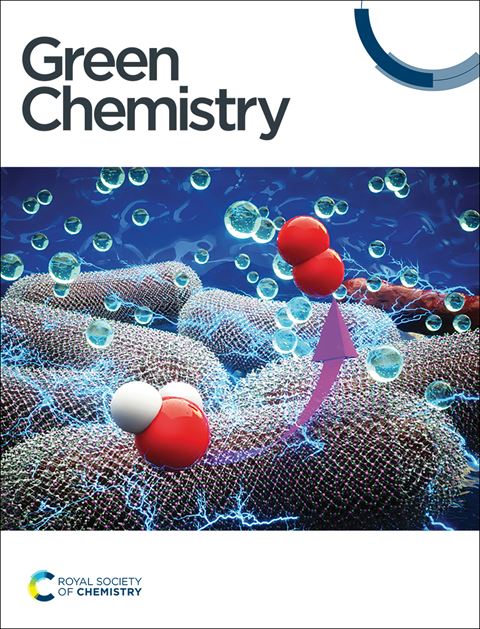Tuning the electronic structure of phosphonic acid-based deep eutectic solvents for synergistic catalytic oxidative desulfurization†
IF 9.3
1区 化学
Q1 CHEMISTRY, MULTIDISCIPLINARY
引用次数: 0
Abstract
Deep eutectic solvents (DESs) hold immense potential in extraction-coupled oxidative desulfurization; however, their efficient utilization, in terms of catalytic activity and cycle-regeneration stability, remains a significant challenge. Herein, we propose a strategy for constructing bifunctional phosphonic acid-based DESs (PDESs) using zinc chloride (ZnCl2) combined with organic phosphonic acids to achieve ultradeep desulfurization by inducing strong electronic interaction via coordination regulation. Through experimental and theoretical screening, the PDES ZnCl2/phenylphosphinic acid (ZnCl2/PIA = 1 : 2), demonstrating strong electron transfer capability and high adsorption energy for oxidants, exhibits remarkable catalytic performance towards the removal of heterocyclic thiophenes. Notably, PDESs can simultaneously function as extractants and catalysts, maintaining a desulfurization efficiency of up to 98.4% even after 12 consecutive cycles under mild conditions, which is much higher than that of previously reported DESs-based desulfurization systems. Furthermore, a possible reaction mechanism is proposed, wherein heterocyclic thiophenes are extracted by the ZnCl2/2PIA PDES via strong interactions (e.g. hydrogen bonding, C–H⋯π and π⋯π) and are then rapidly oxidized by reactive oxygen radicals and peroxy acid in the presence of an oxidant. This study provides a feasible strategy for achieving strong electronic transfer via coordination regulation, aimed at developing high-performance DESs for deep desulfurization and other related application.
调节膦酸基深度共晶溶剂的电子结构用于协同催化氧化脱硫†
深共晶溶剂(DESs)在萃取偶联氧化脱硫中具有巨大的潜力;然而,在催化活性和循环再生稳定性方面,它们的有效利用仍然是一个重大挑战。本文提出了一种利用氯化锌(ZnCl2)与有机膦酸结合,通过配位调控诱导强电子相互作用,构建双功能膦酸基DESs (pdes)的策略,实现超深度脱硫。通过实验和理论筛选,PDES ZnCl2/苯基膦酸(ZnCl2/PIA = 1:2)具有较强的电子转移能力和对氧化剂的高吸附能,对杂环噻吩的脱除具有显著的催化性能。值得注意的是,pdes可以同时作为萃取剂和催化剂,即使在温和条件下连续12次循环后,脱硫效率仍高达98.4%,远高于先前报道的基于dess的脱硫系统。此外,提出了一种可能的反应机制,其中杂环噻吩被ZnCl2/2PIA PDES通过强相互作用(例如氢键,C-H⋯π和π⋯π)提取,然后在氧化剂存在下被活性氧自由基和过氧酸快速氧化。本研究提供了一种通过配位调控实现强电子传递的可行策略,旨在开发用于深度脱硫及其他相关应用的高性能DESs。
本文章由计算机程序翻译,如有差异,请以英文原文为准。
求助全文
约1分钟内获得全文
求助全文
来源期刊

Green Chemistry
化学-化学综合
CiteScore
16.10
自引率
7.10%
发文量
677
审稿时长
1.4 months
期刊介绍:
Green Chemistry is a journal that provides a unique forum for the publication of innovative research on the development of alternative green and sustainable technologies. The scope of Green Chemistry is based on the definition proposed by Anastas and Warner (Green Chemistry: Theory and Practice, P T Anastas and J C Warner, Oxford University Press, Oxford, 1998), which defines green chemistry as the utilisation of a set of principles that reduces or eliminates the use or generation of hazardous substances in the design, manufacture and application of chemical products. Green Chemistry aims to reduce the environmental impact of the chemical enterprise by developing a technology base that is inherently non-toxic to living things and the environment. The journal welcomes submissions on all aspects of research relating to this endeavor and publishes original and significant cutting-edge research that is likely to be of wide general appeal. For a work to be published, it must present a significant advance in green chemistry, including a comparison with existing methods and a demonstration of advantages over those methods.
 求助内容:
求助内容: 应助结果提醒方式:
应助结果提醒方式:


